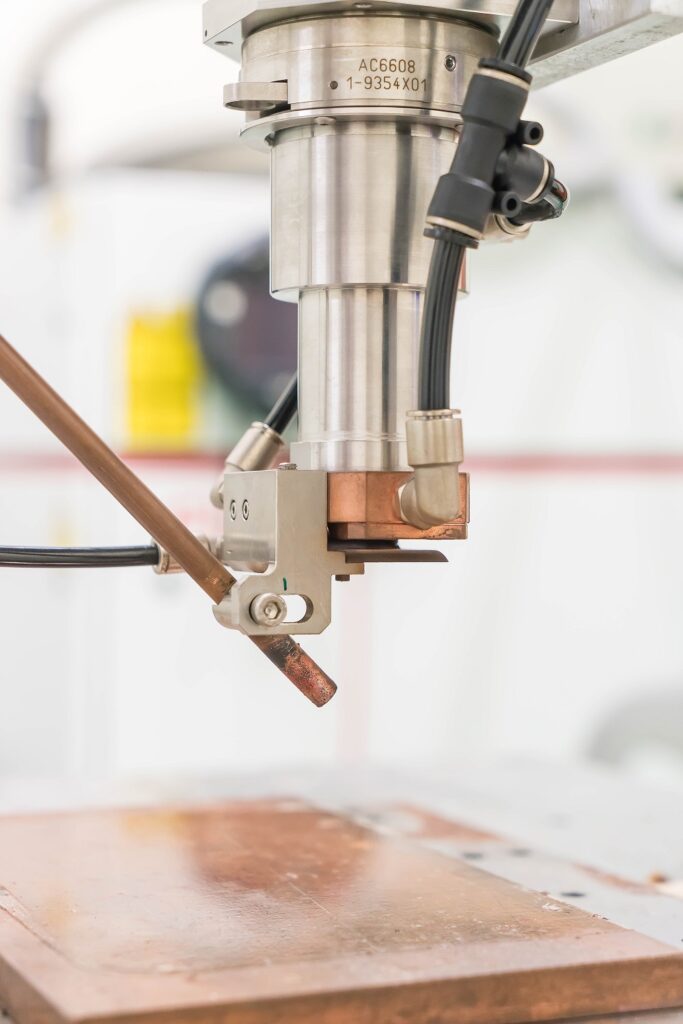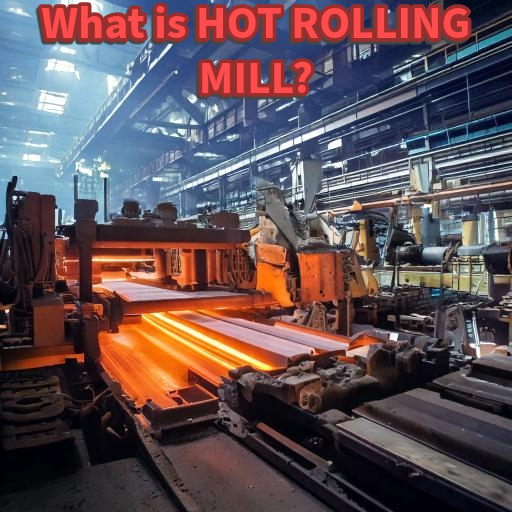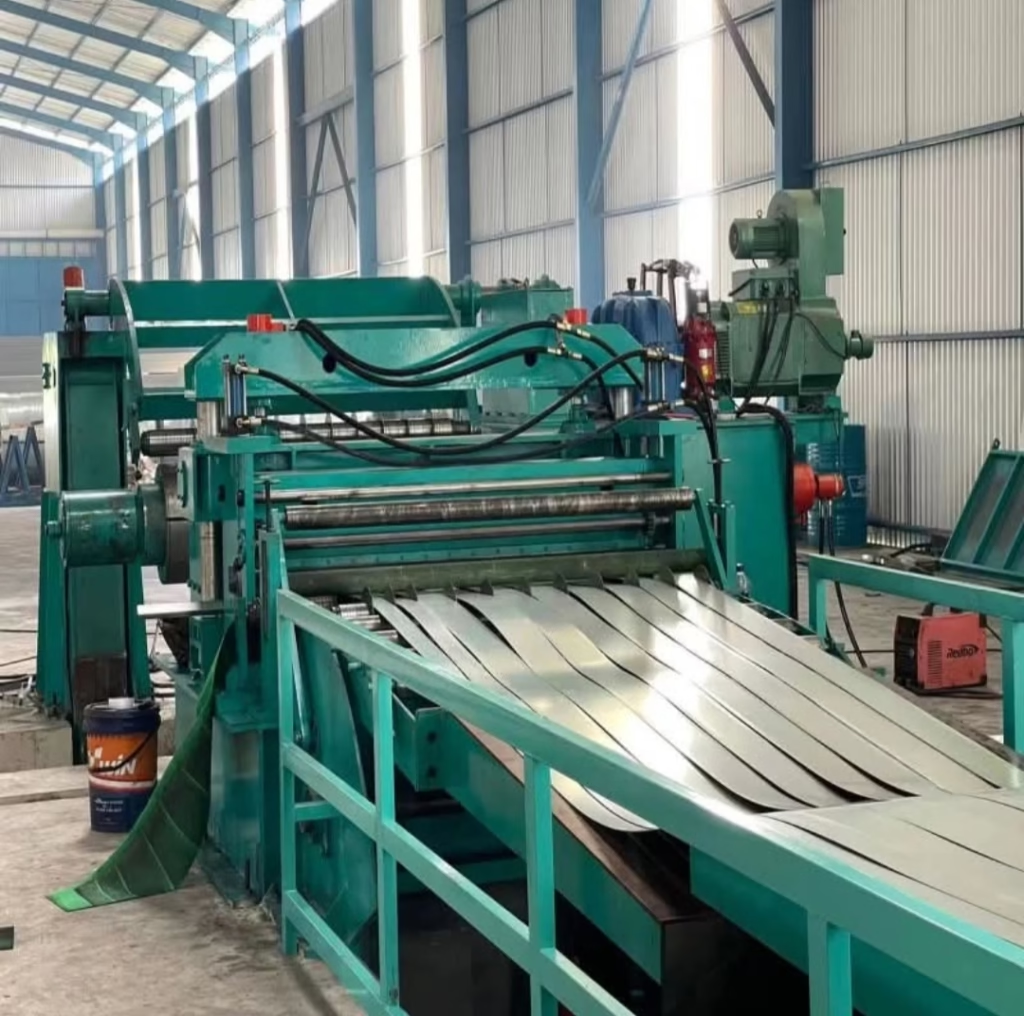Welding process is used to join metals and other metals or materials. Different types of welding machines are required for different applications and different materials. In this article we will know about the types of welding machines and in which applications they are used.
1. Shielded Metal Arc Welding (SMAW) / Stick Welding Machine
Shielded Metal Arc Welding Machine, commonly referred to as Stick Welding, is one of the most frequent and widespread welding processes. The heat from the arc formed melts the metal to create the weld. The flux coating acts as a shield, protecting the weld from coming into contact with contaminants and oxygen.
How does SMAW work?
Electrode Selection: A suitable electrode (stick) is selected according to the metal being welded. For example, E6013 rods are commonly used to weld mild steel.
Arc Creation: The electric arc is created by holding the electrode at a short distance from the workpiece in contact. The temperature of this arc can go up to 3,300°C.
Metal Fusion: The heat from the arc melts the workpiece and the electrode together, thereby fusing both materials into one and creating a strong joint.
Flux Coating: The electrode is flux coated; when heated, the flux vaporizes and gives off shielding gas, which offers the weld protection from oxidation and contamination
Slag Formation: As the flux melts in the arc a slag forms on top of the weld protecting the weld from contamination as it cools. This is removed once final welding is completed
Features of SMAW
Portability: the SMAW is lightweight and compact thus the machine can be used in field jobs.
Low Cost: The equipment and electrodes of this process are cheap and easy to maintain. The cost of the machine starts from 100 USD
Versatile: It can work with different materials such as steel, cast iron, stainless steel, etc.
Simple Setup: Its setup and operation are easy, making it accessible even for beginners.
Applications of SMAW
Construction Industry: Used to weld steel structures of buildings and bridges.
Repair and Maintenance: Used for field repairs such as pipelines, equipment, and machinery.
Industrial Fabrication: Used for welding in heavy-duty industries such as oil and gas and manufacturing plants.
Outdoor Work: Effective even in the presence of wind and moisture, making it suitable for outdoor welding.
Limitations of SMAW
Slag removal is required.
Welding of thin metals is difficult.
Skilled operator is required.
Weld quality is slightly lower than TIG and MIG welding.
2. Metal Inert Gas (MIG) / Gas Metal Arc Welding (GMAW) Machine
MIG welding, also known as Gas Metal Arc Welding machine (GMAW), is a welding process in which a continuous wire electrode is used which melts the weld area and joins the metal pieces. In this process argon or carbon dioxide is used to shield the welded area. This process is fast, efficient and relatively easy, hence it is quite popular among industries and beginners.
Components of MIG Welding
Wire Electrode: A continuous wire electrode is fed from a cylindrical device which provides metal for welding. Generally the material of wire electrode is mild steel or stainless steel and its upper part is coated with copper. But for some applications aluminium is also used.
Shielding Gas: Argon, carbon dioxide (CO₂), or a mixture of the two is used as shielding gas. This gas protects the weld from atmospheric contaminants such as oxygen, nitrogen.
Welding Torch: Delivers the wire electrode and the shielding gas into the weld region. As the welding torch trigger is energized, an arc starts to form.
Power Supply: Constant voltage. The steadiness of the arc is made possible through a constant power supply.
How does MIG Welding Machine work?
The wire electrode is fed continuously from the welding torch during the MIG welding process. When the electrode touches the workpiece, an electric arc is produced that melts the metal. The weld area is protected from contamination by the shielding gas. Once the melted metal cools down, it forms a strong and durable joint.
Advantages of MIG Welding
Speed: MIG welding is relatively pretty fast, therefore its high rate of usage among manufacturing industries.
Easy to Understand: This is a process in which even freshmen can understand its application and utility.
Clean Weld: There is negligible spatter, and slag accumulation, so that the weld formed is very neat and clean.
Versatility: It can well weld thin sheets as well as thick metal components.
Disadvantages of MIG Welding
Outdoor application problem: Moisture and wind affect the shielding gas, thus resulting in poor quality weld.
Cost: The cost of setup and shielding gas is high. The cost of MIG welding machine starts from 250 USD.
Limited Thickness: It is difficult to effectively weld thicker materials.
Applications of MIG Welding
Automotive Industry: It is a perfect option to weld car body parts and thin metal sheets.
Manufacturing: Due to the fast welding process, it is used in mass production and assembly lines.
Repair and Maintenance: To repair broken metal parts.
3. Tungsten Inert Gas (TIG) / Gas Tungsten Arc Welding (GTAW) Machine
TIG welding is a high-quality and very precise process of welding with electrodes made from tungsten. It is mostly applied where cleanliness and high precision, like in automotive or aerospace, are required.
How does TIG welding work?
Tungsten Electrode: TIG welding utilizes tungsten electrodes that generate an arc. This electrode does not melt, hence it is durable and reusable.
Shielding Gas: An inert gas, usually argon or helium, used in protecting the welding arc and molten metal from atmospheric contamination.
Heat Control: In TIG welding, heat is precisely controlled, which produces a high-quality weld.
Features of TIG Welding
TIG welding is known for high-quality and clean welds. Its weld area is smooth and aesthetically appealing. There is no spatter during TIG welding, which makes the work clean and efficient. Due to this it is used in stainless steel tube mills. TIG welding is ideal for materials such as aluminium, stainless steel, magnesium and copper. The welder has complete control over the arc and filler material hence this is a manual and skilled operation.
Applications of TIG Welding
Aerospace Industry: Where light weight and strong components are required such as aircraft parts and fuel tanks.
Automotive Industry: TIG welding is done in manufacturing customized cars. Commonly used in exhaust systems and engine parts.
Artistic Metalwork: TIG welding greatly helps in decorative and artistic designs.
Medical Industry: The process is used for surgical instruments and medical devices where precision and contamination-free welding is a must.
Food and Beverage Industry: In making stainless steel tanks and pipelines that are hygienic and corrosion-resistant.
Limitations of TIG Welding
TIG welding is manually operated and needs a highly skilled operator. Welding speed is very slow in comparison with other welding techniques. The equipment and operation cost is comparatively high.
4. Flux-Cored Arc Welding (FCAW) Machine
Flux-Cored Arc Welding usually abbreviated to FCAW, is the advanced welding procedure that employs the flux-filled wire electrodes while welding metals. It becomes optional for any shield gas or can even weld without shield gas. Both options work just right. During this method of welding, an arc generates between the wire electrode, having flux, and the work which melts the metals through electric flow and finally leads to the strongly built welds.
How Flux-Cored Arc Welding Equipment Works?
Wire Electrode: The flux material is incorporated in this tubular wire-on the formation of the arc, it vaporizes and forms a protecting gas that protects the weld from getting contaminated by atmospheric gases.
Shielding Gas: In using dual-shield methodology, one can improve weld quality with additional external gas shielding in CO₂ and argon. This being so, for a self-shielding FCAW, no additional gases are necessary; the flux available within the wire will be sufficient for such operations.
High Deposition Rate: The deposition rate of FCAW is higher than that of MIG welding. Therefore, it is very efficient in heavy welding works.
Advantages of Flux-Cored Arc Welding
High Welding Speed: it can be applied to welding thick materials.
Portable: Self-shielded FCAW is perfect for use outdoors where shielding gas cylinders are not available.
Versatility: This process works efficiently on carbon steel, stainless steel, and thick sections.
Disadvantages of Flux-Cored Arc Welding
Flux-core welding produces a lot of spatter, which necessitates extra cleaning, a skilled operator is required as weld quality depends on flux and electrode movement. The equipment for this process is quite costly.
Applications of Flux-Cored Arc Welding
Construction Industry: Used to weld bridges, buildings, and heavy structural components.
Shipbuilding: Suitable for marine environments where strong and durable welds are required.
Pipeline Welding: Outdoor and in remote areas, where wind and contamination are issues, FCAW is a reliable option.
Heavy Equipment Repair: Used extensively in the maintenance of mining and earth-moving equipment.
Manufacturing Industry: To fabricate large assemblies and heavy machinery.
5. Submerged Arc Welding (SAW) Machine
Submerged Arc Welding machine is an automatic or semi-automatic welding machine designed to perform high quality and efficient welding. This process uses granular flux which covers the weld area and shields the arc, due to which the welding is very smooth and contamination free.
How does SAW process work?
Arc Formation: An arc is created in the weld area which is formed between a continuously fed electrode and the workpiece.
Role of Flux: The arc and the pool of weld are completely covered with a granular flux. The function of flux is:
•To protect the arc.
• To reduce spatter and weld defects.
• To introduce supplementary alloying elements into the metal.
Molten Weld Pool: The arc heat melts the metal, and the molten metal and flux form a weld bead. Extra flux can be recycled.
Automation Options: The SAW process is more automatic, in which both the electrode and flux are fed at a fixed speed. The machine can also be operated in semi-automatic mode.
Advantages of SAW
High Efficiency: This process has a high deposition rate and speed, which makes it perfect for large-scale production
Consistent Weld Quality: Weld defects are reduced and uniformity is maintained due to flux.
Clean Weld Area: The weld area is entirely covered with flux, thus saving it from any contamination by the atmosphere.
Operator Safety: The arc and spatter are shielded, saving the operator from the effects of UV rays and heat emanating from it.
Disadvantages of SAW
Restricted Position: SAW can only be applied in a flat and horizontal position. It is unsuitable for overhead or vertical welding.
Portability Issues: It is a heavy and stationary setup, unsuitable for portable applications.
Initial Cost: The initial investment in SAW machines and setups is high. However, one can recover this money by producing quantity.
Applications of Submerged Arc Welding Machine
Manufacturing of Pipe: Application in the making of big-size pipelines and pressure vessels.
Ship Building: For an efficient welding method to join heavyweight steel plates together efficiently.
Structural Fabrication: Generally used in manufacturing bridges and in the fabrication of steel structures.
Pressure Vessels: Boilers and storage tanks with high-pressure and high-strength weld requirements
Automotive Industry: Large components and heavy-duty parts.
6. Resistance Welding Machine
Resistance welding is a technique in which metals are fused using electrical resistance and pressure. This welding is very fast, reliable, and efficient, so it is very popular in manufacturing and production industries. There is no need of filler material in this process, and the weld joint is very strong and neat.
Principles of Resistance Welding
Electric Current: High electric current is passed between two metals. This generates heat at the contact point of the metals.
Heat Generation (Joule’s Law): The amount of heat is according to Joule’s law:
H=I2×R×tH = I^2 \times R \times tH=I2×R×t
- I: Current
- R: Resistance of metal
- t: Duration of current
Pressure: After passing current, pressure is applied by electrodes, which solidifies the molten metal and forms a strong joint.
Types of Resistance Welding Machines
1. Spot Welding Machine

How it works: It is used to spot weld two metal sheets at their overlapping points. Current and pressure are applied by circular copper electrodes.
Applications:
- For joining sheet metal panels in the automotive industry.
- In making parts of home appliances such as refrigerators and washing machines.
- Ideal for mass production.
2. Seam Welding Machine
How it works: This process uses rolling electrodes that provide continuous current and pressure. These create a leak-proof seam.
Applications:
- For making fuel tanks and pipelines.
- Manufacturing of cans and containers.
- For liquid-tight and air-tight joints.
3. Projection Welding Machine
How it works: This process welds one or more raised points (projections). Metal parts are designed to be kept in proper alignment.
Applications:
- To weld nut-bolts and fasteners.
- Used in automotive and electrical components.
- Suitable for high-strength welds.
4. Flash Welding Machine
How it works: In this process, metals are heated with high current and short bursts. When the material is in molten state, a weld is made by applying pressure.
Applications:
- Joining the ends of railway tracks and steel pipes.
- Welding heavy parts in aerospace and structural industries.
5. Butt Welding Machine
How it works: Used to join two metal rods or wires end-to-end. Current and pressure create a uniform joint.
Applications:
- In wire manufacturing and chain link production.
- For joining rods, pipes and frames.
Advantages of Resistance Welding Machines
No need for filler material: Process is clean and cost-effective.
High Speed: Ideal for efficient production with automated systems.
Strong Joints: Welded joints are quite strong and durable.
Leak-Proof Welds: Seam welding is perfect for making liquid-tight and air-tight joints.
Limitations
High Initial Cost: Machines and setup are expensive.
Limited Material Thickness: Not efficient for thick metals.
Skilled Operators Required: Trained personnel required for proper operation.
Applications of Resistance Welding Machine
Automotive Industry: Manufacturing of car bodies and frames and mass production of sheet metal parts.
Electrical Industry: To weld electrical contacts and small components.
Packaging Industry: Manufacturing of cans and metal containers.
Construction Industry: To join steel bars and rods.
7. Plasma Arc Welding (PAW) Machine
Plasma Arc Welding, PAW, is an arc welding process similar to TIG, except the plasma gas is used to focus the arc of the weld for higher precision. Plasma is a state of matter whereby the gas becomes electrically conductive and highly heated.
Working Principle of PAW
In PAW the arc is compressed through a nozzle which creates a plasma jet. This jet is at high velocity and temperature which melts the weld area. In this process inert gas (such as Argon or Argon-Hydrogen mixture) is used to create plasma and shielding gas protects the weld from the atmosphere.
Main Components:
Power Source: Constant current power supply to generate plasma arc.
Plasma Torch: Contains tungsten electrode and constricted nozzle.
Plasma Gas: To create plasma arc, usually Argon.
Shielding Gas: To protect the weld from contamination, such as Argon or Helium.
Features of PAW:
High Precision: Plasma jet is very narrow and concentrated, which creates precise and clean weld.
High Temperature: Plasma arc temperature can reach up to 30,000°C, which is helpful in welding difficult materials.
Deep Penetration: Can efficiently weld thick materials.
Automation Friendly: PAW machines can be integrated with robotics and CNC systems.
Applications of Plasma Arc Welding Machines:
Aerospace Industry: For welding high-strength alloys and complex geometries.
Medical Devices: Surgical tools and implants where precise and clean welds are required.
Electronics Industry: Micro-welding applications such as sensors and circuits.
Automotive Industry: Welding of thin sheet metals and intricate parts.
Nuclear Plants: High-quality and defect-free welds are required.
Advantages of PAW:
High Welding Speed: Faster process as compared to traditional TIG welding.
Versatility: Works from thin sheets to thick metals.
Low Distortion: Heat concentration is limited, which reduces material distortion.
Long Electrode Life: Wear-and-tear of tungsten electrode is very less.
Disadvantages of PAW:
High Initial Cost: welding Machine and setup are expensive.
Complex Setup: Skilled operator and precise setup is required.
Not Ideal for All Materials: TIG or MIG is better for some materials.
8. Laser Welding Machine
Laser welding is the modernized process of welding in which a laser beam is used to join metal parts. The term laser, expanded as Light Amplification by Stimulated Emission of Radiation, actually forms an intensified light beam focused at a defined area. The metals get melted by this intense energy and fuse. The process is very well known for its precision, speed, and quality welding.
How does Laser Welding work?
In laser welding, an intense beam of laser is projected onto a metal surface. The moment the laser beam is focused onto a metal surface, it instantly heats the metal; hence, the metal melts and forms a weld pool. The molten metal then solidifies, forming a strong and clean weld joint. You don’t need filler material in laser welding, and the heat it generates is placed in a very precise location with very little heat effect on the surrounding area. It also uses inert gas argon that protects the weld joint, thus preventing the formation of oxides.
Advantages of Laser Welding
High Precision:-The process of laser welding is very precise; it provides narrow weld seams with exact control of depth, making it perfect for complex and delicate applications.
Speed and Efficiency:- The welding speed of a laser is quite high, which is beneficial in mass production and high-volume manufacturing. High speed means you can weld more parts quickly and effectively.
Minimal Heat-Affected Zone (HAZ):- HAZ is the abbreviation for Heat Affected Zone, and in laser welding, there is very minimal HAZ because its beams are very focused. The structure and properties of the surrounding material are, therefore, less affected in this manner.
No Need for Filler Material:- In many cases, there is no need for filler material in laser welding. This saves cost and makes the process simpler.
Automation:- It is easily automated by means of CNC (Computer Numerical Control) systems and robots for repetitive and consistent welds.
Minimal Post-Welding Work:- That is to say, post-welding operations—above all, grinding, and finishing—are reduced to a minimum because welds are clean and smooth as they come.
Applications of Laser Welding Machines
1. Automotive Industry
Laser welding in the automotive industry is done on high-precision parts, body panels, and structural components. All these applications have strict quality control standards alongside them, which laser welding easily meets.
2. Aerospace
In the aerospace industry, laser welding has been used in the welding of some critical components of engines and even turbine blades. The quality and precision of this process are highly essential.
3. Medical Devices
In medical device manufacturing, such as surgical instruments and implants, laser welding is applied. Because this process gives clean and accurate welds, it is ideal for the standards of the medical industry.
4. Electronics
Laser welding is also applied to weld the sensitive parts of electronics that require welding of accurate and thin materials, such as batteries, connectors, and circuit boards.
5. Jewelry Manufacturing
Laser welding finds its application in jewelry manufacturing also, where it joins the small parts and intricate designs. This kind of welding has high precision, which makes it straightforward to weld small and delicate designs.
6. Tooling and Dies
Laser welding is also applied in the manufacture of tooling and dies due to its ability to precisely and effectively join the parts of a tool together where strength and durability is required.
Types of Laser Welding
Conduction Welding
In this the laser energy does not penetrate the metal surface but heats the surface. This creates shallow welds and the surface finish is very smooth.
Keyhole Welding
In this, the laser beam has a high degree of penetration, creating a “keyhole” in the metal. This method is used in the case of high penetration welds and helps to carry out deep welds.
Parts of Laser Welding Machine
Laser Source
The core component of a laser welding machine is the laser source, which generates a high-intensity laser beam. These can be solid-state lasers, fiber lasers, or CO₂ lasers.
Beam Delivery System
This system uses mirrors and fiber optics to deliver the laser beam to the workpiece. This system is very precise and maintains the laser as a focused beam.
Welding Head
The welding head focuses the laser beam on a surface and controls the welding process.
Cooling System
High heat is generated during laser welding, so a cooling system is used that protects the laser source and machine from overheating.
Control Unit
The control unit monitors the welding process and adjusts the machine settings, such as laser power, speed and focus.
Limitations of Laser Welding
High Initial Cost:- Laser welding machines are quite expensive, so the initial investment is high. It can be expensive for small-scale operations.
Material Compatibility:- Laser welding is not possible with every material. The high thermal conductivity of metals like copper and aluminum makes them difficult to laser weld.
Skill Requirement:-Laser welding requires precise control and calibration, so skilled operators are required who can handle the machine properly.
Summery
Laser welding belongs to the class of very progressive and exacting methods, so it is preferably used in those industries asking for high quality and high precision welds. Its main application can be found in the automotive, aerospace, medical, and electronic sectors. Some of its advantages, including high-speed characteristics, precision, and the lack of necessity in post-weld working, have given the place to laser welding among today’s modern processes of manufacturing. Otherwise, disadvantages related to high initial investment and incompatibility with materials render this process applicable for definite purposes.
Conclusion
It always depends on the requirement of the work and also the type of material. In outdoor situations, where riddling the process is at large, especially under rugged conditions, stick welding stands superior in these cases; for precision work, TIG and Laser do better jobs compared to MIG welding. Using a MIG welder makes learning the craft very easy.
Each machine has its own specialties, and the right machine makes your project both efficient and cost-effective.




Pingback: ERW Tube mill